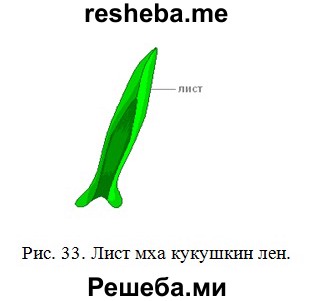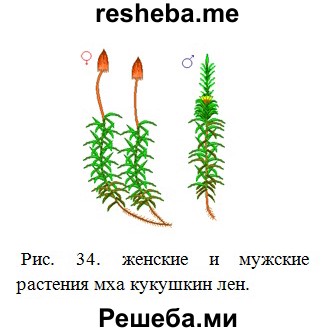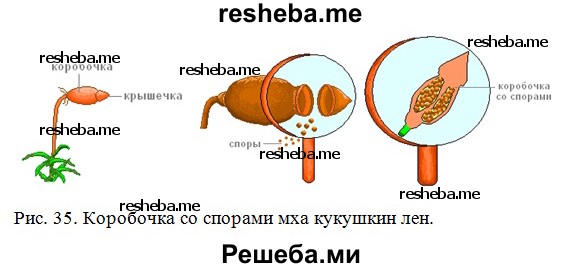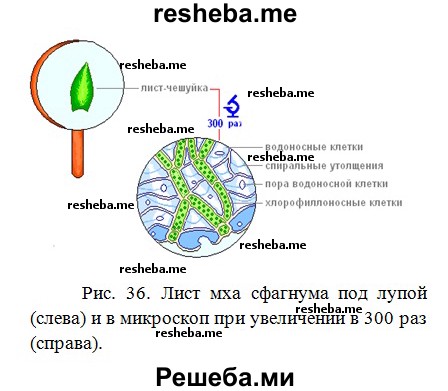Question 1. What are rhizoids?
Rhizoids - filamentous formations from one or more single-row cells; serve to attach to the substrate and absorb water and nutrients from it. Available in mosses, lichens, some algae and fungi.
Question 2. Why are algae classified as lower plants?
Algae belong to the lower plants, because they have no roots, no stems, no leaves.
Question 3. What is a dispute?
Spores are microscopic rudiments of lower and higher plants that have different origins and serve for their reproduction and (or) preservation under adverse conditions. In biology, the concept of "dispute" is divided into:
* spores of bacteria that serve to wait out adverse conditions;
* spores of plants, sporozoans and fungi that serve for reproduction.
Laboratory work No. 10. The structure of moss.
1. Consider a moss plant. Determine the features of its external structure, find the stem and leaves.
Stem erect, not branched. The length of the stem is 12 cm, but can reach 30-40 cm. The stems are densely covered with leaves. At the top there is a box with spores. At the bottom of the stem there are outgrowths - rhizoids.
2. Determine the shape, location, size and color of the leaves. Examine the leaf under a microscope and draw it.

The leaves are concave dark green, have a petiole around the stem. Each leaf on its upper surface has assimilation plates and a large main vein. The leaf looks like a thick needle and miniature flax plants. The lower leaves on the stem develop in the form of scales.
3. Determine if the plant has a branched or unbranched stem.
Moss has an unbranched stem.

At the tops of male plants are the reproductive organs, in which mobile sex cells (gametes) - spermatozoa - develop.
In female plants, the genital organs are located at the tops with the female reproductive cell (gamete) - the egg.
On female plants, boxes on long legs develop, covered with hairy pointed caps. They look like a sitting cuckoo. Spores develop in the boxes. Spilling out and germinating, they form new moss plants.
5. Examine the spore box. What is the importance of spores in the life of mosses?

The plant produces numerous spores. Spilling out and germinating, they form new moss plants. From each spore, under favorable conditions, an shoot develops with a short lifespan, which looks like a box (sporangium) on a stalk.
6. Compare the structure of moss with the structure of algae. What are their similarities and differences?
Differences: algae do not have roots, their body is represented by a thallus. Mosses develop rhizoids. Algae live only in aquatic environments, mosses only live in humid environments. Mosses have stems and leaves, but algae do not.
Similarities: cells have plastids (chloroplasts, chromoplasts, leukoplasts), so they can carry out photosynthesis. Grows indefinitely throughout life. Motionless.
7. Write down your answers to the Questions.
Conclusion: mosses are more developed than algae. They may no longer be in water, but in a humid environment. Stems and leaves are already emerging.
Question 1. Why are mosses called higher spore plants?
Since the body of mosses is divided into stems and leaves, and they reproduce by spores, they are classified as higher spore plants.
Question 2. What is the structure of cuckoo flax?
Its slender brownish stems are covered with small dark green leaves and look like miniature flax plants.
Cuckoo flax has male and female plants. At the tops of male plants, the genital organs are located, in which mobile sex cells (gametes) develop - spermatozoa (from the Greek words "sperm" - seed, "zoon" - a living being and "eidos" - species). In female plants, the genital organs are located at the tops with the female reproductive cell (gamete) - the egg.
On female plants, boxes on long legs develop, covered with hairy pointed caps. They look like a sitting cuckoo. Hence the name of the moss - cuckoo flax. Spores develop in the boxes. Spilling out and germinating, they form new moss plants.
Question 3. How is sphagnum different from cuckoo flax?
Kukushkin flax - green moss, sphagnum - light green moss, peat. Cuckoo flax has rhizoids, sphagnum does not. In cuckoo flax, the stem does not branch, and in sphagnum there are branches of three types, in the leaves of cuckoo flax there are no dead cells, and in sphagnum there are a large number of them, these are air-bearing cells capable of absorbing moisture. Boxes with spores in cuckoo flax have a hairy cap and an elongated shape, in sphagnum they are without a cap and rounded. Cuckoo flax plants are male and female, while sphagnum plants are bisexual. Boxes with spores in cuckoo flax are located on the tops of female plants one by one, and in sphagnum 3-5.
Question 4. How is moss different from algae?
Mosses are more complexly organized than algae. Among the algae there is a large group of unicellular, all mosses are multicellular organisms. Most algae live in the aquatic environment, most mosses live on land, but with a high percentage of humidity. The body of moss is differentiated into organs; only in the most developed algae can one observe something similar to tissues. Mosses have external differences between males, females, between sexual and asexual generations. In algae, all individuals of the same species are the same. Mosses cannot reproduce vegetatively, but algae can. Mosses have stems and leaves, like all higher plants, and algae have thallus.
Question 5. What is the importance of mosses in nature and human life?
Mosses, settling in meadows, in forests, cover the soil with a continuous carpet, making it difficult for air to enter. This leads to acidification and waterlogging of the soil.
Leaf-stemmed, especially sphagnum, mosses cover swamps with a continuous carpet and, dying, form peat, which is widely used by man. Peat is used as a fuel, fertilizer and as a raw material for industry. Wood alcohol, carbolic acid, plastics, insulating tapes, resins and many other valuable materials are obtained from peat. Some animals eat moss.
Think
Why don't even the largest mosses reach sizes over 80 cm?
Mosses are not tall because in places where they grow there is very "poor" soil. Frosts and strong winds are rather unfavorable conditions for existence. Mosses do not have a conductive system and, as a result, have limited height growth.
Quests for the curious
1. Examine the leaves of sphagnum moss under a microscope. Note the structural features of the two types of cells of which they are composed.

There are two types of cells in leaf cells. Narrow green cells in which photosynthesis takes place (there is chlorophyll) are connected at the ends and form a mesh structure in which organic substances move. Between them are large transparent dead cells, of which only shells remain (they contain water).
2. Place some riccia in a jar of damp soil. Cover the jar with glass and place in a warm, bright place. Make sure the soil is constantly moist. Watch what happens with Riccia.
Riccia will begin to develop as favorable conditions (from moist and warm air, light). Floating Riccia does not have rhizoids, but it can form them on damp soil.
If you grow Riccia in water, if the temperature is lower than 20°C, the growth of Riccia slows down, but the appearance remains attractive. You also need to know that soft water is considered optimal for this plant, the hardness of which should not exceed 15 units, but if this figure is higher than 8, this already negatively affects growth. The acceptable pH level is 4-8.
